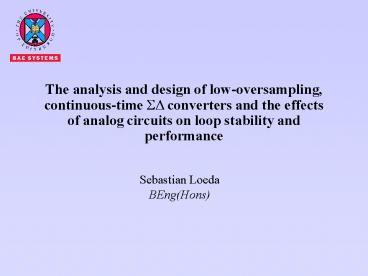Sebastian Loeda BEng(Hons) - PowerPoint PPT Presentation
1 / 23
Title:
Sebastian Loeda BEng(Hons)
Description:
Create a DT model of the noise response. Model the quantization noise transfer function (NTF) ... cost with primitive integrator. Qs & (hopefully) As. Thank you! ... – PowerPoint PPT presentation
Number of Views:48
Avg rating:3.0/5.0
Title: Sebastian Loeda BEng(Hons)
1
Sebastian Loeda BEng(Hons)
- The analysis and design of low-oversampling,
continuous-time ?? converters and the effects of
analog circuits on loop stability and performance
2
Overview
The analysis and design of low-oversampling,
continuous-time ?? converters and the effects of
analog circuits on loop stability and performance
- Background
- Low oversampling, continuous-time ?? converters
- Loop delay effects
- Loop delay compensation by optimization
- Integrator circuit response finite DC gain
- Integrator circuit response high frequency pole
- Conclusion
- Future work
3
Introduction
- A/D converter bottleneck to any sensor system
- Particularly true for radar
- ?? conversion achieves high-resolution with
- Oversampling (error averaging),
- Limited by technology and bandwidth (here is low)
- Feedback (quantization noise shaping)
- Limited by the order of H(s), and may be unstable!
4
Analysis of CT ??
- Challenge due to mix of DT and CT
- Create a DT model of the noise response
- Model the quantization noise transfer function
(NTF) - NTF(z) 1/(1H(z))
- Mapping cannot be an approximation!
5
Poles and zeros of NTF(z)
6
Loop delayNTF(z)
7
Loop delay SNR
8
Design-by-optimization
9
Loop delay t compensationResonator H(s) fixed
poles
10
Loop delay t compensationFree poles of H(s)
11
Resonator Vs Free poles of H(s)
- Two regimes
- Resonator optimum for low values of t ( 0.2)
- Real poles optimum for moderate values of t
- But lose noise notch
- Unusual!
- What about H(s)?
12
Ideal integrator model in H(s)large OSRs
H(s)
13
Realistic integrators
- Finite DC gain
- High frequency poles and zeros
- What is the impact of circuits on the loop
performance and stability for low OSR?
14
Illustrative exampleIntegrator model to second
order
(?2 proportion of sampling frequency)
15
Effects of finite DC gainNTF(z)
Start 100dB
End 0dB
16
Effects of finite DC gain SNR
17
Effects of second pole ?2NTF(z)
Start 10fs Hz
End 0.5fs Hz
18
Effects of second poles ?2 NTF(z) (altogether)
19
Effects of second poles ?2 SNR
20
Summary
- First integrator stage is critical
- Wide bandwidth required but
- Must be low noise!
- The later the stage the lesser the effect
- Third a bit more sensitive than expected
- due to feedback in H(s), i.e. zeros of NTF(z)
- Can cope with loop delay
- Use of real poles of H(s)
- DC has a limited effect
- As long as it is kept reasonably high
- But note 3rd unusually sensitive
- ?2 is very important!
- Gets worse with low OSR
- Only one pole considered for illustrative
purposes!
21
Conclusions
- With low OSRs, cannot design a CT ?? without
taking into consideration the integrator
circuits response! - Compensation
- Add zeros in In(s)
- What are the optimal zero positions?
- Mitigate circuit effects by optimising the model
- Expect similar mitigation seen for loop delay
- Advantages of design-by-optimization
- Optimum has zero matrix jacobian, i.e. robust
- Add circuit design criteria as optimization
constraints (e.g. bound component sizes) - Caveat
- Depends on how well characterised the technology
is
22
Future work
- Achievements
- Generalised the mapping for
- Any H(s)
- DAC shape and timings
- OSR
- Fast, general and accurate
- Essential for more sophisticated integrator/DAC
models - Assess the impact of circuits on CT ?? with a
z-domain model - Developed a design-by-optimization technique
- Future aims
- Create integrator models from realistic circuits
- Optimise directly on component values
- Cascaded CT ??
- Practical advantages
- Increase performance out of good integrator
circuit - Reduce cost with primitive integrator
23
Qs (hopefully) As
- Thank you!

